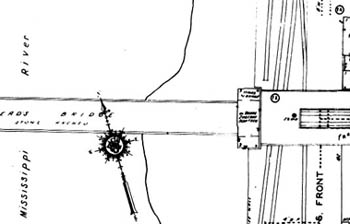 The Eads Bridge
The Eads Bridge
Even as steamboats plied the waters of the Mississippi River off the shore
of East St. Louis during the latter part of the nineteenth century, businessmen
recognized the value of connecting East St. Louis and St. Louis by a bridge
spanning the Mississippi. As early as the 1820s, the promise of railroads
offered land transportation free from the limits of America's great rivers.
By the 1860s railroads proved to
 |
| A section of a 1920s Sanborn Fire Insurance Map showing
the Illinois side of the Eads Bridge. University of Illinois Library. |
be a reliable means for transporting passengers and cargo. Entrepreneurs
on both sides of the Mississippi understood that a bridge would give railroads,
carts, and pedestrians an easy way to cross the river. A bridge would
reduce delays for moving freight westward then caused by the need to stop
trains in East St. Louis and transport goods across the river by ferry.
A bridge would further the capital growth these investors had already placed
in the American Bottom region. A bridge was the next step to securing
St. Louis as permanent transportation point between the East Coast and
the expanding west.
To learn more about building railroad bridges, go to the
RiverWeb
Archives and view excerpts from J.L. Ringwalt's 1888 book, The Development
of Transportation Systems in the United States.
 The Eads Bridge
The Eads Bridge The Eads Bridge
The Eads Bridge